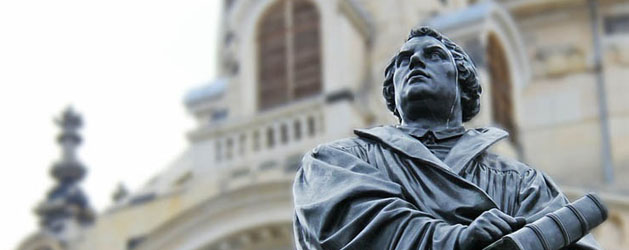
WW I & II History 12 Day Tour
Including the Normandy Beaches of France to Berlin, Germany.
April - November for Groups
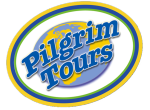
Wholesale Tour Packages Since 1987 - Call Us Toll Free: 800.322.0788

Including the Normandy Beaches of France to Berlin, Germany.
April - November for Groups
| Dates |
|---|
| Request a quote or call 800-322-0788 for more information. |
|
Ask About Special Rates for Pastors, Christian Educators, & Custom Groups of All Sizes. No Obligation Group Quotation - Click Here |
Price Includes: Lodging in superior tourist class & moderate first class hotels, full time tour escort / local city guides, breakfast & dinner daily, porterage (1 checked bag), all guides, entrances and transportation as appear on itinerary, services of long distance deluxe motorcoach as appear on itinerary.
Not Included: Airfare/ air taxes, July 10 optional Pergamon Museum ($37.00 per person), tips (suggested $9.00 per person per day), lunches, optional travel insurance, optional credit card payments (additional 3% of total bill).
Airport transfers are included only when airfare is purchased from Pilgrim Tours. Taxi service is available for those purchasing their airfare elsewhere.
Deposit Required: $300 per person will reserve your place. A $100 service fee will be charged for cancellation at any time in addition to our normal payment and cancellation policy.
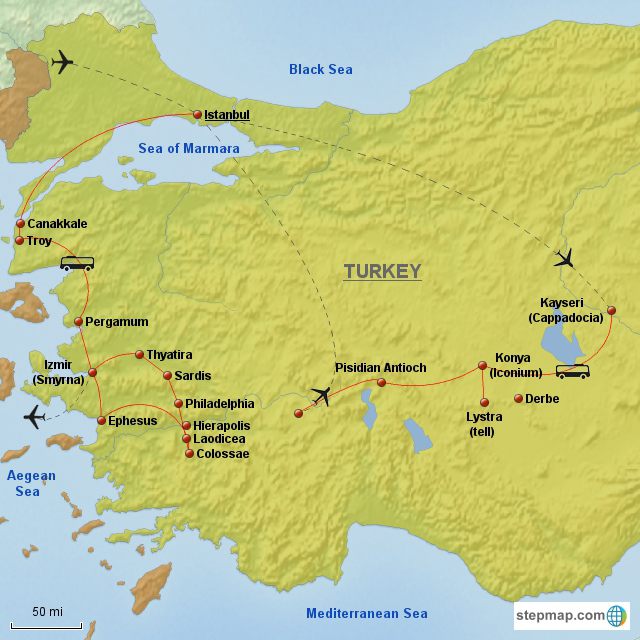
Day 1: Departure for Paris
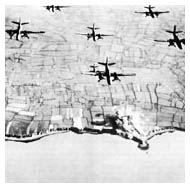
Prepare yourself for a life-changing experience as today we embark on our Journey to Europe. We have meal services in flight on our way to Paris, France.
Day 2: Arrive Paris, Caen
Arriving in Paris we meet our guide who assists us to our motorcoach. We immediately head out of the city and north towards the Normandy Coast. En-route to Caen we stop at the Memorial Pour La Paix. This museum houses exhibits relating from WWII to present day. We arrive at our hotel where we have dinner and overnight the next three nights in Caen.
Day 3: Normandy American Beaches, Ste. Mere Eglise
This morning we depart to the D-Day landing beaches including Omaha and Utah Beaches. Our first stop will be at the American Cemetery overlooking the eastern end of Omaha Beach. We will take this time to pay our respects to the deceased at the hundreds of crosses and stars of David. Entrance to the Peace Memorial is included. We begin our in-depth tour of the area battlefields by stopping at Pointe Du Hoc, a sheer cliff some forty meters high. It is here that the US Army Rangers stormed cliffs with collapsible ladders and grappling hooks to get onto Omaha Beach. Omaha Beach was a site where very little went according to plan. Unexpectedly strong defenses led to heavy U.S. casualties in the first waves of landings. Then see the Dog Green sector of Omaha Beach, made famous by the movie "Saving Private Ryan." Losses were especially high here. We will study the battlefields; cross the beaches, analyze the maps and imagine the courage that saved our freedom that day. Our final visit of the day is to Ste. Mere Eglise taken by the American Airborne on D-Day. The town was made famous by the paratrooper John Steel and by the film "The Longest Day". John Steel managed to land on the church and his chute caught on the steeple. He hung there while the fighting continued on the ground for two hours before being cut down by the Germans, taken prisoner and later released by the Americans. We will also stop at the Paratrooper Museum housing many interesting artifacts including a DC3 aircraft used on D-day together with a glider. We return to the hotel for dinner and overnight.
Day 4: British & Canadian Beaches
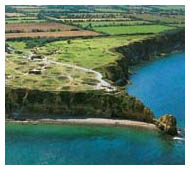
After breakfast at the hotel, our tour begins where the first shots were fired, at the crucial Pegasus Bridge. We continue on the way to the guns at Longues-sur-Mer, the battery against which HMS Ajax scored perhaps the most accurate (and perhaps the luckiest) hit of the war. We'll see the evidence that remains. On Gold Beach we will see what remains of Port Winston where allied troops unloaded supplies during the invasion of June 6, 1944. A score of landing ships struck mines and suffered damage of various degrees. Specialist teams of underwater demolition experts were forced to struggle through the water while disabling mines and blowing the other obstacles, all under heavy sniper fire from the remaining German defenders. At the same time, the British were also landing at Sword beach. As part of the defenses, the Germans had set up mine fields, concrete sea walls and anti-tank ditches. By the end of the day nearly 30,000 allied troops had landed at Sword Beach. Juno, the landing beach for Canadian forces, was the second most heavily defended of the five landing sites chosen. The seawall was twice the height of Omaha Beach's, and the sea was also heavily mined. This afternoon we'll view the Bridge at Troarn, the D-Day objective of the 3rd Parachute Squadron, Royal Engineers. We return to Caen for dinner and overnight.
Day 5: Compiegne (Railroad Car), Reims
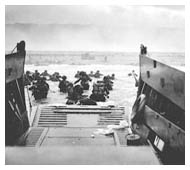
Woodrow Wilson called World War I "The war to end all wars." Although hindsight is always 20-20, this prediction was wildly wrong. In one of the ironies of history, our troops in eastern France in 1944-45 retraced some of the same battlefields where American "doughboys" fought in 1918. When Adolf Hitler received word from the French Government that they wished to negotiate an armistice, Hitler selected Compiegne Forest near Compiegne as the site for the negotiations. As Compiegne was the site of the 1918 Armistice ending the Great War with a humiliating defeat for Germany, Hitler saw using this location as a supreme moment of revenge for Germany over France. In the very same railway carriage, Hitler sat in the same chair that Marshal Ferdinand Foch had sat in when he faced the defeated German representatives. We continue on to Reims for the evening and a tour of the Cathedral, made famous by the damage done during World War I. Time Permitting; we also visit the MUMS champagne facility.
Day 6: Belleau Wood, Argonne Forest, Verdun, Luxembourg
We'll visit Chateau Thierry (Belleau Wood Battlefield), where U.S. Army and Marine Corps troops helped to stop the German advance from reaching Paris. In the Meuse-Argonne Region, we'll see the Pennsylvania State Monument and the American Memorial at Montfaucon. It was in the Argonne Forest that Sergeant Alvin York showed his extraordinary courage and marksmanship, and the "Lost Battalion," led by a Wall Street lawyer called up from the reserves, was surrounded by the Germans for five days, refusing to give up. World War I on the Western Front was largely trench warfare - a four year stalemate where millions of soldiers were killed or wounded. Although American troops were not involved, we will also visit Verdun. The Battle of Verdun, lasting from February to December 1916, was the longest and largest single battle in world history. In planning for the Second World War, senior generals on both sides were determined to avoid the futile slaughter of trench warfare. Our lodging for the next two nights will be in Luxembourg.
Day 7: Battle of Bulge, Maginot Line
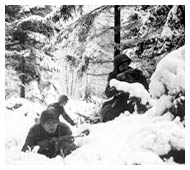
The Battle of the Bulge, as the Ardennes Campaign is widely known, was the largest land battle of World War II. It was also the largest battle ever fought by the American Army. This last offensive of the German Army cost 19,000 Americans killed in action. But our troops held the line and the offensive was a disaster for the Germans, who had put their soldiers in a noose to be cut off by reinforcing Americans under General Patton. We'll visit Bastogne, where our soldiers were surrounded for a week, and see the town's monuments to this epic battle. When the Germans sent a delegation to accept the surrender of U.S. troops in the Bastogne region, General McAuliffe responded with what became the most widely quoted comment of the war in Europe -"NUTS!" We continue our sightseeing along the Maginot Line, a series of permanent fortifications built to protect France's borders with Germany and Italy. A stop will be included to view the major fort at Hackenberg, the largest of the Maginot Line fortresses with 17 combat blocks. Tours of the fortress include the main munitions storage area, engine room, barracks, and kitchen; a museum of Maginot Line uniforms and weapons; an electric train ride to one of the artillery combat blocks (block 9), and a visit inside and outside of block 9 to see how a 135mm howitzer turret operates. We return to Luxembourg for dinner and overnight.
Day 8: Romantic Road, Rothenberg, Wurzburg
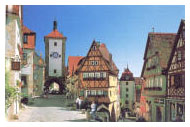
This afternoon we stop along the panoramic "Romantic Road" to visit the best preserved medieval town in all of Europe, Rothenburg. We include the quaint Rathaus (town hall) with its tower, the Kriminal-museum, housing all manner of Medieval instruments of torture and, especially for the ladies, one of the most fascinating Christmas stores you will ever see - Kathe's (pronounced Katie's). After free time, our trek north through the fertile countryside brings us to Wurzburg for dinner and overnight.
Day 9: Buchenwald Concentration Camp, Berlin
We travel northward through the German countryside and stop for a tour of Buchenwald Concentration Camp. Buchenwald remained one of the major camps throughout the history of the Third Reich, with numerous sub camps under its administration. The camp was liberated by the U.S. Army on 11 April 1945. The American soldiers found that the inmates had already taken the camp over, after most of the SS guards fled, and were organizing its surrender. Buchenwald was one of the first glimpses that Americans had of the horrors of the concentration camp system. Our lodging for the next three nights will be in Berlin.
Day 10: Berlin Tour, Pergamon Museum
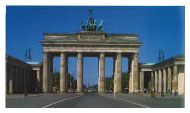
Berlin was the political, spiritual, and cultural center of the Nazi regime. As Hitler said, "Who controls Berlin controls Prussia, and who controls Prussia controls Germany." Sightseeing this morning includes the Wilhelmstrasse from Unter den Linden to Niederkirchnerstrasse (Prince Albrecht Strasse during the Third Reich.) These four blocks were the nerve center of Nazi rule - including Hitler's Chancellery and Bunker, Goebbels' Propaganda Ministry, Goering's Luftwaffe Headquarters, (still standing today) Ribbentrop's Foreign Office, and Himmler's Gestapo Headquarters. See Potsdam Square, the Brandenburg Gate, and a remnant of the infamous wall. See the Russian War Memorial, Alexander Square, and drive along Unter den Linden, the main avenue of pre-war Berlin. See the recently dedicated Holocaust Memorial near the Brandenburg Gate. Our tour ends at the top of the Kurfurstendam (Ku'damm), dominated by the bombed out shell of Kaiser Wilhelm Memorial Church and its new, starkly modern replacement. These buildings have become symbols of the Old and New Germany. They are among the most impressive sights in Europe. We return to the hotel for dinner and overnight.
Day 11: Free Day Berlin
Today is free. Transportation will be provided for those who wish to visit the marvelous Pergamon Museum. The Pergamon houses original-sized, reconstructed monumental buildings such as the Pergamon Altar, the Market Gate of Miletus, and the Ishtar Gate of ancient Babylon, all consisting of parts transported from the original excavation sites. We have our final dinner and overnight in Berlin.
Day 12: Home
We have an early morning departure for the Berlin Airport for our flight homeward allowing for arrival home by early afternoon.
*The tour itinerary is subject to change or be slightly modified in order to best meet the interests of the group.